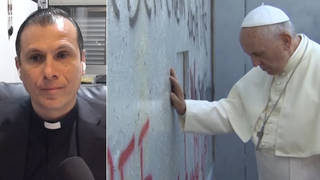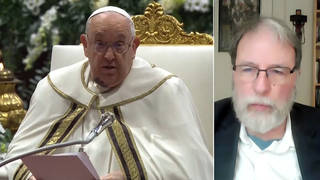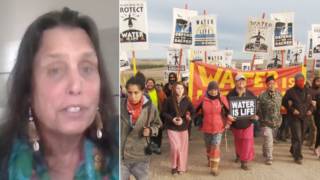
Topics
Guests
- Rhiana Gunn-Wrightone of the lead policy writers for the Green New Deal. She is the policy director for the nonprofit New Consensus.
Links
In a move Congressmember Alexandria Ocasio-Cortez called a “bluff vote,” the Senate rejected the Green New Deal on Tuesday, after 43 Democrats voted “present” on the measure introduced by Republican Senate Majority Leader Mitch McConnell. Four other Democrats joined all 53 Republican senators in voting against the Green New Deal. As Democrats blast McConnell’s move to push the procedural vote, we speak to one of the lead policy writers for the Green New Deal, a proposal to transform the U.S. economy by funding renewable energy while ending U.S. carbon dioxide emissions by 2030. Rhiana Gunn-Wright is the policy director for the nonprofit New Consensus.
Transcript
NERMEEN SHAIKH: The Senate on Tuesday rejected the Green New Deal, after 43 Democrats voted “present” on the measure introduced by Republican Senate Majority Leader Mitch McConnell. Four other Democrats joined all 53 Republican senators in voting against the Green New Deal. Democrats, including the bill’s champion, New York Congressmember Alexandria Ocasio-Cortez, blasted McConnell’s move to push the procedural vote, calling it, quote, “bluff vote.” The Green New Deal seeks to transform the U.S. economy through funding renewable energy while ending U.S. carbon dioxide emissions by 2030. Democratic leaders have resisted backing the deal, which has the support of all 2020 Democratic presidential hopefuls in Congress.
AMY GOODMAN: On Tuesday, Republican Senator Mike Lee of Utah ridiculed the Green New Deal. During a 14-minute speech on the Senate floor, he showed a series of fantastical images that included former President Ronald Reagan riding a dinosaur and Aquaman on a giant purple sea horse. Lee also evokes Luke Skywalker from Star Wars riding a tauntaun, a mythical snow lizard, to belittle the Green New Deal. This is parts of Lee’s speech.
SEN. MIKE LEE: I rise today to consider the Green New Deal with the seriousness it deserves. This is, of course, a picture of former President Ronald Reagan, naturally firing a machine gun while riding on the back of a dinosaur. … This image has as much to do with overcoming communism in the 20th century as the Green New Deal has to do with overcoming climate change in the 21st. … Tauntauns, Mr. President, … while perhaps not as efficient, in some ways, as airplanes or as snowmobiles, these hairy bipedal species of space lizards offer their own unique benefits. … All residents of Hawaii would be left with is this. This is a picture of Aquaman. … I draw your attention, Mr. President, to the 20-foot impressive seahorse he’s riding. Under the Green New Deal, this is probably Hawaii’s best bet.
AMY GOODMAN: On Twitter, Congressmember Alexandria Ocasio-Cortez accused Senator Lee of not taking his job seriously. She wrote to her followers, quote, “If this guy can be Senator, you can do anything.” This is Congressmember Ocasio-Cortez speaking on the Senate floor in a clip that has been watched more than 10 million times.
REP. ALEXANDRIA OCASIO-CORTEZ: When we talk about the concern of the environment as an elitist concern, one year ago I was waitressing in a taco shop in Downtown Manhattan. I just got health insurance for the first time a month ago. This is not an elitist issue; this is a quality-of-life issue. You want to tell people that their concern and their desire for clean air and clean water is elitist? Tell that to the kids in the South Bronx, which are suffering from the highest rates of childhood asthma in the country. Tell that to the families in Flint, whose kids have—their blood is ascending in lead levels. Their brains are damaged for the rest of their lives. Call them elitist. You’re telling them that those kids are trying to get on a plane to Davos? People are dying.
AMY GOODMAN: That’s Alexandria Ocasio-Cortez.
Well, for more, we’re joined right now by Rhiana Gunn-Wright, one of the lead policy writers for the Green New Deal. She’s the policy director for the nonprofit New Consensus.
Rhiana Gunn-Wright, welcome to Democracy Now!
RHIANA GUNN-WRIGHT: Thank you.
AMY GOODMAN: It’s great to have you with us.
RHIANA GUNN-WRIGHT: It’s wonderful to be here.
AMY GOODMAN: Before you explain exactly what the Green New Deal is and what you are working on, leading to 2020, can you explain what happened in the Senate this week? What was this procedural vote that Congressmember Alexandria Ocasio-Cortez called a “bluff vote”? She called it a sham. What happened? And why did the Democrats abstain?
RHIANA GUNN-WRIGHT: Right. So, Mitch McConnell, or, I should say, Majority Leader McConnell, decided that he wanted to do this vote a while back, when the Green New Deal started to pick up steam. And this was the fruition. It actually got pushed back once or twice. And from my estimation—I focus on policy, so I’m not an expert on the political side—was that it was really an effort to embarrass Democrats, to show cracks in support for the Green New Deal, and essentially to try to stop the momentum.
And my understanding of the Democratic response was that there is a deep interest in the Senate in keeping the momentum of the Green New Deal going, but some members don’t want to vote on it until there’s more policy. So this was the middle path that they chose in order to still allow the Green New Deal to develop policy, to grow legs and to continue moving forward.
NERMEEN SHAIKH: Well, what do you know about what Democrats—at the moment, what their opposition to the Green New Deal is?
RHIANA GUNN-WRIGHT: Largely, it’s that the resolution is a nonbinding resolution that sets out goals and doesn’t have policy specifics right now. And so that is the main opposition. And my understanding, I think there are some fears also about cost and feasibility from particular senators. But I think it’s also important to recognize that all of the senators who are currently running for president have backed the Green New Deal. And, of course, Senator Markey has been a champion and is a veteran climate hawk. So, there is definitely pronounced support in the Senate, but there’s also some reservation. So, I—
AMY GOODMAN: So, this, what happened with the voting down of it and all the Democrats’ abstentions, that doesn’t mean that they do not support the Green New Deal?
RHIANA GUNN-WRIGHT: No.
AMY GOODMAN: So, explain what is. What’s the resolution that Congressmember Ocasio-Cortez and Senator Markey put forward? And what is still in process? What is evolving?
RHIANA GUNN-WRIGHT: So, the resolution that came out set out high-level goals for the Green New Deal. And in a lot of ways, it was meant to be a marker in the sand, to say these are the goals of the Green New Deal, these are the projects that are part of the Green New Deal, and this is the approach that the Green New Deal has to take, particularly around issues of equity and justice. So, that’s what the resolution sets out, and it was always meant to be a floor, to be a marker.
And so, what’s happening now, a lot of the work that we’re doing at New Consensus is the policy development. We now have the goals. We have the projects. So we’re trying to figure out, along with a cadre of experts involved in movement, policy and academia, what is a smart path forward on all of these goals and how do we actually achieve the things set out in the resolution.
NERMEEN SHAIKH: Well, I want to talk about one of the issues that you raised about people’s concerns about the Green New Deal—
RHIANA GUNN-WRIGHT: Right.
NERMEEN SHAIKH: —namely expense, including Democrats. Last month, California Senator Dianne Feinstein came under fire after a video showing her interaction with a group of youth climate activists, some as young as 7 years old, went viral. In the video, Feinstein dismisses the students’ demands to take action on climate change, including supporting the Green New Deal. Let’s go to part of that exchange.
RIO: We’re trying to promote the Green New Deal.
SEN. DIANNE FEINSTEIN: Well, there are reasons why I can’t, because there’s no way to pay for it.
UNIDENTIFIED: Yes, there is.
SEN. DIANNE FEINSTEIN: That’s a big reason.
MAGDALENA: We have tons of money going to the military.
UNIDENTIFIED: Where is the money from Bush’s wars?
MAGDALENA: Half of our—a lot of money is going to the military.
SEN. DIANNE FEINSTEIN: Well, I understand that. The United States government does a lot of things with the money. And they’re important things. And you just can’t go in and say, “OK, we’re going to take hundreds of millions from here and hundreds of millions from there.” It doesn’t—it just doesn’t work that way.
NERMEEN SHAIKH: So, that’s Senator Dianne Feinstein speaking last month. Rhiana, can you talk about what exactly is the expense of the Green New Deal? And even more, what’s the expense of not acting on the Green New Deal?
RHIANA GUNN-WRIGHT: So, the expense of the Green New Deal is largely unknown, because there are no policy specifics. But there is plenty of research and evidence about the cost of decarbonization, which is exactly what the Green New Deal sets out, and also the benefits from green jobs. So, one smaller green jobs report, that professor Robert Pollin put out, recognizes—and it’s far smaller in scope than the GND—and for that, it was 2.7 million net jobs created. So—and most analyses of green jobs, especially if you’re going to go complete net zero, you see millions of jobs. Similarly on the cost side, deep decarbonization grows our economy. Rocky Mountain Institute, they say that it will grow the economy, deep decarbonization, two-and-a-half times the American economy and save $5 trillion. So, there are studies—not from us—out there about what these things cost to implement, and also the benefits and the savings that come.
On the cost of not implementing it, those are more known, but there’s a lot of questions, because a lot of those estimates actually we don’t know all of the second-order effects, so the costs will likely be greater. But last year NASA found that the U.S. economy lost $91 billion to climate change alone. And there’s other estimates that $500 billion, 2 percent of GDP, was lost from climate change.
NERMEEN SHAIKH: And what about the fact that Republicans have been saying such bizarre things about the Green New Deal? I mean, we just saw, you know, a dinosaur and a tauntaun and so on. So, you know, what is that about, and how can you possibly combat that?
RHIANA GUNN-WRIGHT: Right. Well, the reality is they’re not taking this seriously. They’re not taking this threat seriously. And the ways that we combat that, at least at New Consensus and in the context of the Green New Deal, is being willing to work with everyone, but also not pegging our hopes or our vision to Republican talking points or Republican solutions on climate, which, clearly, if you’re showing dinosaurs, there are none.
AMY GOODMAN: President Trump told Fox News Wednesday that he wants to campaign against the Green New Deal, so he doesn’t want it killed off right away.
PRESIDENT DONALD TRUMP: I don’t want to speak badly about the New Green Deal, Sean, because, frankly, I’m afraid that they’ll stop using it, because I really do want to, you know, campaign against it. It’s ridiculous, all right? It’s crazy. And it’ll cost $100 trillion. Nobody knows what that means. That means it’s more money than you have in the world. And it will be catastrophic. It’s not going to happen. It’s just talk.
AMY GOODMAN: “It’s not going to happen. It’s just talk,” Rhiana Gunn-Wright. So, tell us the substance of it, not only the science of the Green New Deal, but also the issues of, for example, how you’re going to address the racial wealth disparity and why you see that connected to a Green New Deal.
RHIANA GUNN-WRIGHT: Well, there’s a couple reasons that we see that as connected to the Green New Deal. One is, of course, a moral argument. A lot of the people who are dying from fossil fuel pollution or who are carrying the heaviest burden are people of color, and they’re poor people of color. And likely, when climate change picks up and we see more disasters, more deaths, those are the first people who are on the line. People like to say climate change will kill us all, but the truth is climate change will kill some people first. And so, there’s a moral imperative to make sure that in the green transition the same people who bear the brunt of our reliance on fossil fuels are not the same people who the green transition is being built on their backs. So that’s one.
And then the second is that income inequality and climate change are linked, not only because we have an extractive economy, but because there’s a growing body of evidence that, especially in rich countries, the higher you have income inequality, the more emissions that you have. The mechanisms are not clear, and there’s lots of theories about it, but the evidence is clear. And so, if you’re going to tackle climate change and tackle it in a way that’s sustainable, you have to be talking about inequity. You have to be talking about racial equity, as well, because those are drivers. Right?
And the ways that we think about addressing that is making sure that the policies are crosscutting, right? And so, say, one of the examples in the bill is upgrading all homes and buildings. You can structure that program, through federal jobs guarantees, through local programs, through incubators and just through the structure of how you split up the work between different types of buildings, to make sure that people of color are benefiting. And another way that we’re constantly thinking about the racial wealth gap is: How do you make sure that this transition brings not only income, but that income can be translated to wealth, particularly for people that are more likely to be unbanked?
So those are the things that we’re thinking about. And those are the reasons we think that it’s incredibly important—right?—to make sure that racial equity is involved. And also, from past mobilizations like World War II and the New Deal, the other thing that we see is, when certain people aren’t involved or included, you see those effects for generations. And we don’t want another set of problems that we’re dealing with just kicking the can down the road.
AMY GOODMAN: We just have 15 seconds, but front-line communities, why this is so important, why your climate legislation is so different from others?
RHIANA GUNN-WRIGHT: Right. Well, there’s a couple reasons. Like I said, those people are the people who are most on the line. But then, the second, there’s a political reason. People of color and folks in front-line communities are much more inclined to care about climate change. The issue is that they don’t have the resources. They face a ton of existential threats that are not just climate. So, if you can link the two and do it successfully while continuing to focus on deep decarbonization, you could open up a whole new bucket of climate voters in a situation where power, particularly when the GOP is so intransigent, is going to be crucial to passing any climate legislation, large or small.













Media Options